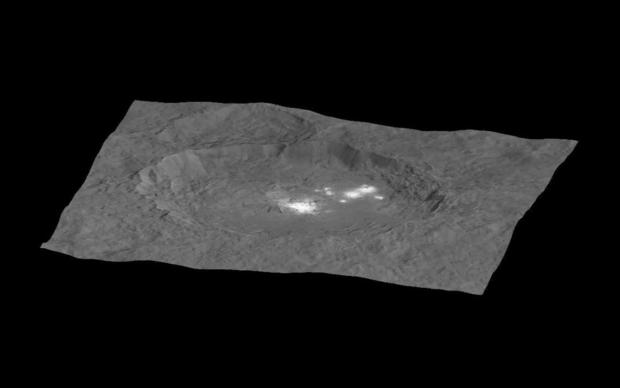NASA Animation Shows Mystery Bright Spots On Planet Ceres Using Images From Dawn Spacecraft
SAN FRANCISCO (CBS) -- Intriguing bright spots in a crater on the dwarf planet Ceres, the largest body in the asteroid belt between Mars and Jupiter, are coming into sharper focus as NASA's Dawn spacecraft studies the small world from a 915-mile-high mapping orbit. It will descend to an altitude of just 230 miles or so later this year.
The bright spots were first detected by Dawn's instruments during its approach to Ceres, prompting widespread speculation about possible ice or salt deposits, volcanic eruptions of some sort, icy geysers or impacts that exposed a layer of brighter material below the surface.
The latest images from Dawn reveal surface features as small as 450 feet across. The two bright spots are now resolved into one very bright area near the center of a crater known as Occator with about eight smaller concentrations to one side surrounding an area that has the appearance of frost or snow.
Researchers with the Dawn project have not yet weighed in on what the bright material might be, whether it was deposited from above or whether it welled up from below.
"Dawn has transformed what was so recently a few bright dots into a complex and beautiful, gleaming landscape," Marc Rayman, Dawn's chief engineer and mission director, said in a NASA news release. "Soon, the scientific analysis will reveal the geological and chemical nature of this mysterious and mesmerizing extraterrestrial scenery."
Dawn arrived at Ceres on March 6 and has been slowly spiraling in to lower and lower altitudes. It reached the intended high-altitude mapping orbit, or HAMO, in early August and in December, the spacecraft is expected to drop down to a low-altitude mapping orbit just 230 miles above the surface of the dwarf planet.
The spacecraft is expected to map the entire surface of Ceres six times during its current orbit, allowing mission scientists to assemble stereo views of surface features and 3D maps. The Dawn mission is expected to continue through June 2016.




